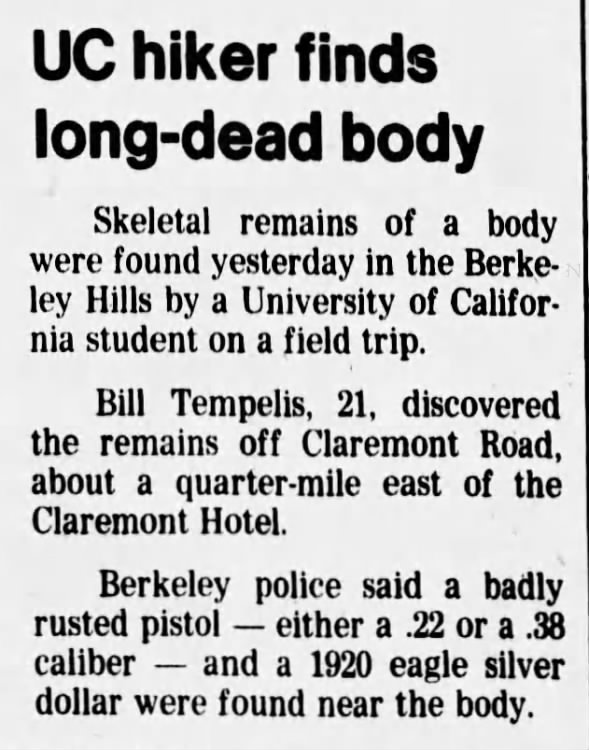By: Shane Lambert
Time of writing: December 9th, 2020
The following case was interesting to do some research on. It's NamUs #UP51552 and it involves the discovery of human remains that were long deceased.
The decedent was found on February 26th, 1978. He was a white male in life and an adult. His height was estimated to be between 5'8" and 5'10" with a weight that could not be estimated. According to NamUs, he was dead since as early as 1940. NamUs also states that the skulls and bones of the man were "found by students who were planting trees in the area."
The date of his death is interesting to debate. NamUs does state that the man was in possession of a 1920 US mint half-dollar (the coin was near the body). Of course, the man having a coin that was, assumingly, his from 1920 doesn't actually mean a lot about his time of death except that it didn't happen before that year. For jewelry, NamUs also stated that the man had a "Yellow metal Elgin pocketwatch." I guess finding the person's time of death wasn't as simple as checking the time.
The news on this case was a little different than what's stated at NamUs. That's not to say that one source is better than the others. But one article said that the body was found by a singular hiker, not tree planters. The source I found was the San Francisco Examiner on Feb 27 1978 (page 32). That source named one "Bill Tempelis" as the discoverer of the body "off Claremont Road." Furthermore, the police described in the article as claiming that "a badly rusted pistol" was near the body, a pistol of .22 caliber or .38. The news article described the coin as a "1920 eagle silver dollar" (article embedded below).
As far as identifying this person goes, the date of the coin is interesting as a clue. However, the pocket watch is probably more of a clue when it comes to conjecture. According to an article at The Atlantic, "By the Great Depression, wristwatch production had eclipsed pocket-watch production; by World War II, the pocket watch was obsolete" (Uri Friedman/May 27th 2015 article at The Atlantic).
The Great Depression happened in the 1930s and the start of the second world war was 1939. NamUs claim the body was there from "as early as 1940" but maybe they are wrong. Could be the body was there as early as 1920. That's the year of the coin and it's the decade where the pocket watch was still a little in style.
When I search for "Elgin Pocket Watch" in newspapers.com, the earliest hit is in the Los Angeles Times on December 15th, 1918 (snipped below). There could be many explanations for that: the brand might not have been popular before then, it might have been new at that time, or maybe they just didn't advertise in newspapers. However, the decade of the 1920s produced 1279 hits at the time of writing and the 1930s saw more than triple that. The keywords peaked in the 1940s at 6129 hits. When I add the word yellow, the results go down by quite a lot but the same trend is present for popularity.
When it comes to the gun, all the caliber means is how wide the barrel is. A .22 caliber gun is 0.22 inches and a .38 caliber gun is a lot wider. It is significant that they couldn't tell the caliber of the gun. Guns are made of metal -- I think it would take a lot of weathering for a gun to deteriorate. To me, the rusted gun, the coin, and the pocket watch all speak to a man who was dead for several decades as of his discovery in 1978. I would estimate a time of death in the 1920s. In order words -- good luck in identifying this cowboy.
 NamUs #UP51552 Mon, Feb 27, 1978 – 32 · The San Francisco Examiner (San Francisco, California) · Newspapers.com
NamUs #UP51552 Mon, Feb 27, 1978 – 32 · The San Francisco Examiner (San Francisco, California) · Newspapers.com


.jpg)
.jpg)

.jpg)




No comments:
Post a Comment